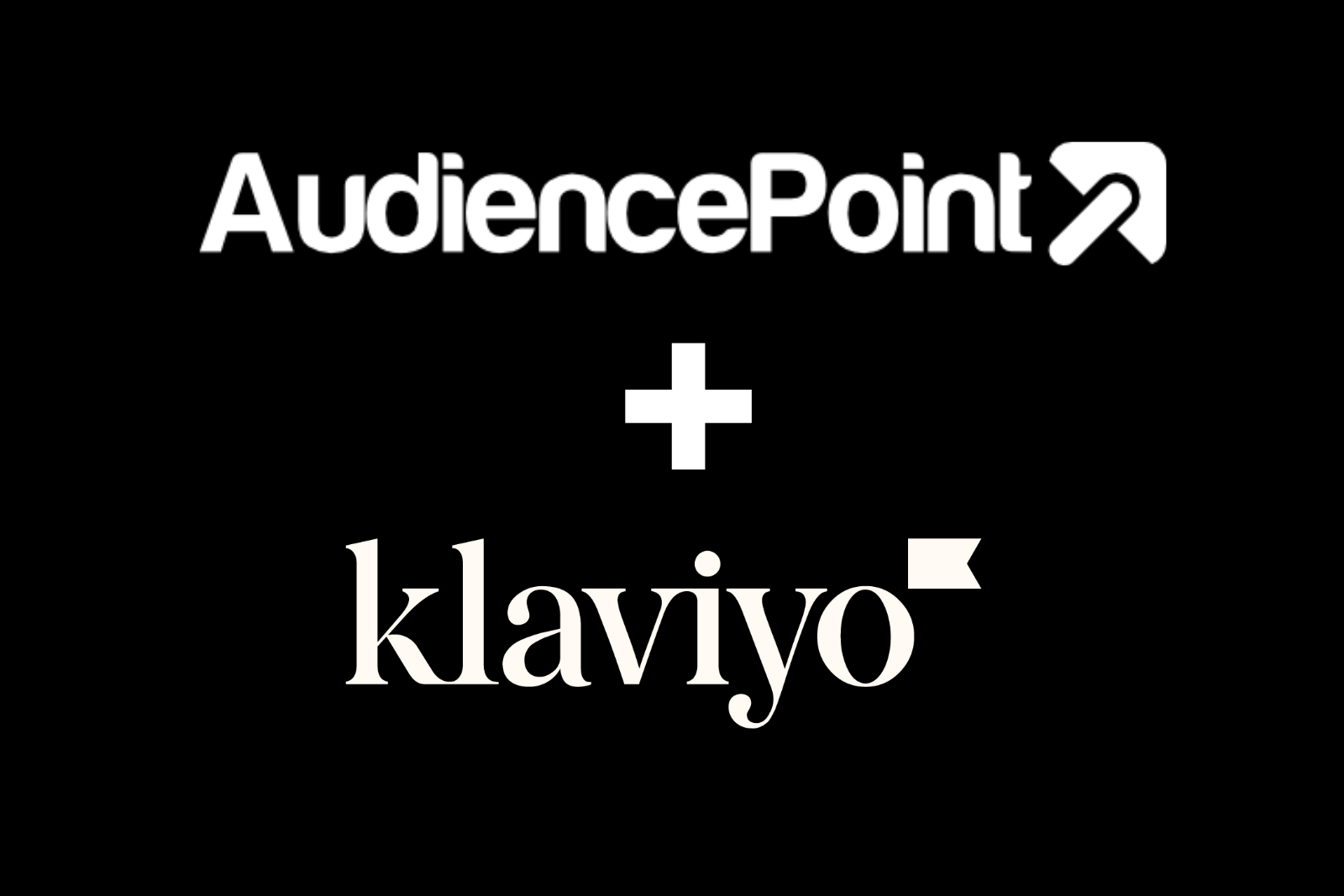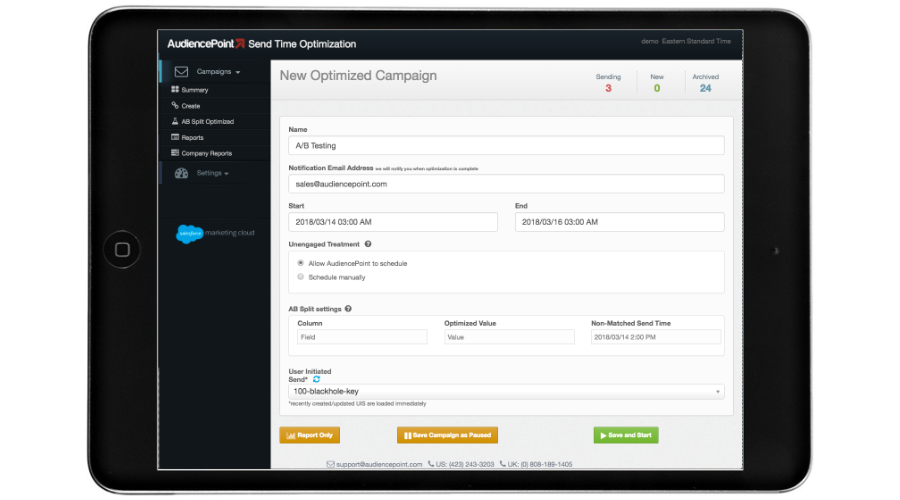AudiencePoint is thrilled to announce our new integration with Klaviyo! AudiencePoint is looking for partners to pilot our...
What Is the Best Email Newsletter Platform?
When determining what the best email newsletter platform is, it’s essential to focus on how well a solution can drive deliverability, engagement, and ROI. The true “best” platform goes beyond simple delivery and flashy templates. It must scale seamlessly, offer deep analytics, and integrate with your marketing stack to support sophisticated segmentation and automation at enterprise scale. AI in Email Marketing is also becoming a critical differentiator, enabling smarter personalization, predictive insights, and enhanced campaign performance.
What Defines a Top-Tier Email Newsletter Platform?
Email newsletter platforms empower brands to create, distribute, and analyze campaigns while managing subscriber relationships. The best options distinguish themselves with superior scalability, unrivaled email deliverability, advanced analytics, and robust integration capabilities for CRMs and marketing automation. Equally important for enterprise teams is the platform’s ability to segment, automate, and re-engage at scale, making marketing efforts both efficient and highly targeted.
Key Criteria: Scalability, Deliverability, and Analytics
For marketing executives handling vast and complex data, the ideal platform must deliver on several fronts: scalability to manage growth, advanced deliverability to bypass spam folders, and granular analytics to measure success accurately. Integration with your existing martech and CRM ecosystem is non-negotiable—seamless data flow powers real-time personalization and smarter targeting. Without these, you risk hamstrung segmentation and underwhelming results.
Why It Matters for Enterprise Marketers
Enterprise email marketing demands more than bulk sending. Automation, sophisticated segmentation, and the ability to act on real engagement data make the difference between mediocre and market-leading outcomes. Legacy approaches fail to offer the precision and actionable insight required. This is where an advanced, engagement-focused solution is vital.
What Is the Most Popular Email Platform?
The most popular email platform often varies depending on business size and target audience, but for many marketers, Mailchimp, Constant Contact, HubSpot, and Klaviyo routinely top the list. Mailchimp’s user-friendly interface and broad adoption, especially by small and mid-size businesses, make it the default choice for many new marketers. However, for enterprise-scale brands and those prioritizing advanced segmentation and automation, platforms like HubSpot and Klaviyo have carved out significant market share.
Enterprise email marketers can’t afford to make choices solely based on popularity. Market share numbers may imply reliability and usability, but they don’t always guarantee the robust feature sets needed for sophisticated campaigns. For example, while Mailchimp offers ease of use and an extensive library of integrations, it may fall short when granular audience segmentation or advanced deliverability control is required. Constant Contact appeals to small businesses with its simplicity, but enterprise organizations may find its workflow and automation tools lacking in flexibility.
Adoption Rates and Market Presence Among Enterprises and Small Businesses
Mailchimp enjoys significant penetration with over 13 million users and a strong SMB focus, but its market dominance is less pronounced in the enterprise sector. HubSpot is recognized for powerful CRM integration and nurtures a large suite of marketing functionalities, which is highly valued by B2B teams. Meanwhile, Klaviyo’s explosive growth in the e-commerce sector is due to its best-in-class segmentation and automation tailored for retail brands. Constant Contact maintains steady adoption among traditional businesses embracing digital transformation for the first time. Each of these players holds a unique niche, but no one platform universally addresses the nuanced needs of complex, data-driven enterprises.
Strengths and Limitations of Popular Platforms
When selecting an email marketing platform, it’s vital to weigh usability against enterprise demands like email deliverability and inbox placement. Popularity often correlates with streamlined onboarding and a shallow learning curve, but this can come at the expense of advanced analytics, integration depth, and performance monitoring. Top-tier brands require a solution that gives them more than just surface-level metrics. They need actionable insights and the ability to adapt quickly to shifting consumer engagement patterns across massive lists.
Why Popularity Doesn’t Always Equate to the “Best” for Enterprises
Enterprise marketers face unique challenges: re-engagement of inactive users, IP warming at scale, and compliance with ever-changing privacy regulations. These demands necessitate platforms that go beyond core sending functions. While mass adoption signals trust and reliability, these platforms may lack advanced features crucial for optimizing inbox placement and ensuring ROI at scale. For high-volume senders, specialized tools that offer precise deliverability insights surpass what generalist platforms can deliver. Ultimately, the best choice for enterprise success doesn’t hinge on popularity but on capability, scalability, and measurement sophistication.
Which Is the Best Email Marketing Platform for Performance and Scalability?
The best email marketing platform for performance and scalability is one that excels not only in message delivery but also in ensuring those messages go directly to the inbox, providing actionable analytics, and seamlessly automating your campaigns across large and growing lists. For enterprise-level marketers, these platforms must also be robust enough to handle complex segmentation, offer deep integrations, and provide comprehensive support for deliverability and inbox placement. The most highly ranked solutions are those that combine enterprise agility with innovative reporting, ensuring your messages reach the right people at exactly the right time.
Critical Features To Look for in a Scalable Email Marketing Platform
Enterprise email marketers should place a premium on scalable email marketing capabilities. This means looking for platforms that guarantee high email deliverability rates, offer real-time inbox placement monitoring, and provide granular, actionable performance analytics. Automation must be sophisticated enough to drive complex, multi-step journeys, and the platform should seamlessly integrate with your CRM, data lakes, and marketing stack. Additionally, robust compliance and security are non-negotiables for today’s data-driven organizations.
Comparison of Leading Platforms: Enterprise Features & Integrations
Popular contenders like Salesforce Marketing Cloud, Adobe Campaign, and Klaviyo offer a range of advanced segmentation, automation, and analytics—making them go-to choices for many enterprises. However, while these platforms shine in user experience and core functionality, most remain reliant on outdated metrics, such as mere delivery or open rates, and have limited visibility into true inbox placement. True differentiation today lies in leveraging advanced data sets for smarter targeting and proactive deliverability management.
The Role of Inbox Placement Monitoring
Historically, platform evaluations hinged on deliverability—the ability of an email to reach the recipient’s server. Today’s landscape, however, demands far more: inbox placement guarantees the message actually reaches the user’s primary inbox, not a promotions or spam folder. Without robust monitoring and adjustment, even premium content and sophisticated automations go unseen. This is the new performance battleground.
AudiencePoint: Leading With Data and Deliverability
AudiencePoint raises the bar by leveraging insights from over 85 trillion tracked events, providing enterprise marketers with a level of deliverability intelligence and engagement data unmatched in the industry. By monitoring real user interaction across a massive second-party data pool, AudiencePoint guides you to suppress problematic addresses, optimize re-engagement, and refine segmentation to boost ROI. This empowers marketers not just to reach inboxes at scale but also to fill them with messages that convert.
Don’t settle for email platforms that only get your messages delivered. Demand one that maximizes actual inbox reach and actionable engagement. AudiencePoint’s unrivaled data insights, automation compatibility, and inbox visibility put you in control of your outcomes. See how industry leaders are redefining their email marketing performance with AudiencePoint. Schedule a personalized demo and accelerate your success today.
Which Email Marketing Tools Are Best for Free or Growing Lists?
For small businesses and marketers managing rapidly growing lists, free email marketing tools can be an effective entry point. Platforms like MailerLite, Sendinblue, and Moosend stand out for their generous free tiers, each providing a balance of user-friendly interfaces and essential features. However, when sending to a list size of around 10,000 email contacts for free, it’s crucial to recognize both the advantages and limitations that come with these solutions.
Which Email Marketing Platforms Offer Free Plans for Large Lists?
MailerLite often appeals to startups thanks to its intuitive design and a free plan supporting up to 1,000 subscribers and 12,000 emails per month. Sendinblue also presents a compelling offer, allowing unlimited contacts on its free tier, though daily send limits apply. Moosend’s entry-level pricing is competitive, helping organizations with expanding email lists keep costs manageable. Although these free tiers help small businesses test email marketing strategies without financial risk, list limits, capped sends, and fewer automation features are common drawbacks.
What Are the Trade-Offs of Using Free or Low-Cost Email Marketing Platforms?
The most significant trade-off with free or bare-bones plans is reduced functionality in areas that matter most for long-term success—namely, advanced analytics, segmentation, deliverability controls, and inbox placement monitoring. While sending emails cost-effectively to larger audiences is appealing, enterprise-level requirements demand more robust engagement metrics, superior deliverability, and advanced integrations. Many free tools cut corners on these parameters, leaving marketers in the dark about why emails underperform or land in spam folders, especially as lists scale.
When Does It Make Sense to Transition From Free Tools to Enterprise Solutions?
As your email list breaches the 10,000-subscriber mark and your marketing objectives expand, the need for a data-driven, enterprise-grade platform like AudiencePoint becomes critical. Advanced platforms provide not only scaling capabilities but also grant access to real-time engagement data, deliverability optimization, and precise inbox placement insights. Email marketers ready to accelerate revenue, mitigate deliverability risks, and maximize the value of every send can no longer rely on limited free platforms. Instead, leveraging a solution like AudiencePoint ensures your communication reaches the right audience at exactly the right time.
Why Enterprise Marketers Need Advanced Inbox Placement Tools
Inbox placement and email deliverability are often used interchangeably, but for enterprise marketers intent on performance—and protecting revenue—the distinction is mission-critical. Deliverability measures whether your emails reach the intended server; inbox placement focuses on whether those emails land in the primary inbox or slide into spam and promotions folders, where engagement plummets. For large-scale campaigns, great deliverability numbers can mask a silent crisis if too many emails are being filtered away from your customers’ eyes.
How Traditional Metrics Mask the Real Story
Open rates, clicks, and delivered counts have long been the barometer for email marketing success. But these aggregate statistics can create dangerous blind spots. Many solutions report high deliverability, yet ignore the critical intermediary step—inbox placement. Without true inbox monitoring, you may be missing the fact that a large percentage of your campaign, although technically ‘delivered,’ never reaches the recipient’s main inbox and goes unengaged. This quickly undermines sender reputation and shrinks your active audience, creating a downward spiral in future campaign performance.
Why Audience-Level Analytics and Real-Time Visibility Are Non-Negotiable
Modern enterprise marketers can’t afford to guess or rely on outdated seed lists or panel data. The future—and the present—are defined by tools that harness actionable audience-level analytics. Advanced solutions like AudiencePoint leverage real behavioral signals from over 85 trillion tracked events, providing actionable insight into which emails hit primary inboxes and which get relegated to spam. By identifying and suppressing problematic addresses, marketers can maximize their mailable universe, optimize content, and ultimately extend reach and ROI.
Why Top Brands Choose AudiencePoint
The world’s most demanding brands turn to AudiencePoint because we deliver real-time, actionable intelligence for every send. Our unique approach to performance monitoring empowers marketers to swiftly re-engage lapsed subscribers, surgically verify email activity for data hygiene, and benefit from precision inbox placement analytics. This level of control and transparency leads directly to increased engagement, rapid revenue acceleration, and long-term deliverability health.
Take the Lead—Make Inbox Placement Your Edge
If you’re ready to transform your enterprise email marketing, it’s time to demand more than basic reporting. AudiencePoint arms you with real-time, accurate inbox placement data and strategic recommendations tailored from the world’s deepest pool of engagement intelligence. Don’t leave ROI on the table—schedule your demo today and see how AudiencePoint can elevate your campaigns to elite performance levels.
AudiencePoint’s Perspective: Putting Engagement and Deliverability First
AudiencePoint recognizes that ultimate performance is about more than just getting emails delivered. It’s about precision inbox placement, verified engagement, and dynamic targeting. By leveraging real activity across 85 trillion tracked events, AudiencePoint empowers marketers to finally see where every campaign lands and how subscribers respond, closing the gap between visibility and actionable results.
If you’re ready to stop guessing and start driving record-breaking engagement, discover how AudiencePoint transforms email from a basic channel into your enterprise’s top-performing revenue engine. Experience unmatched inbox placement, actionable analytics, and the industry’s best re-engagement capabilities—schedule your custom demo with AudiencePoint and lead your brand to email excellence.





